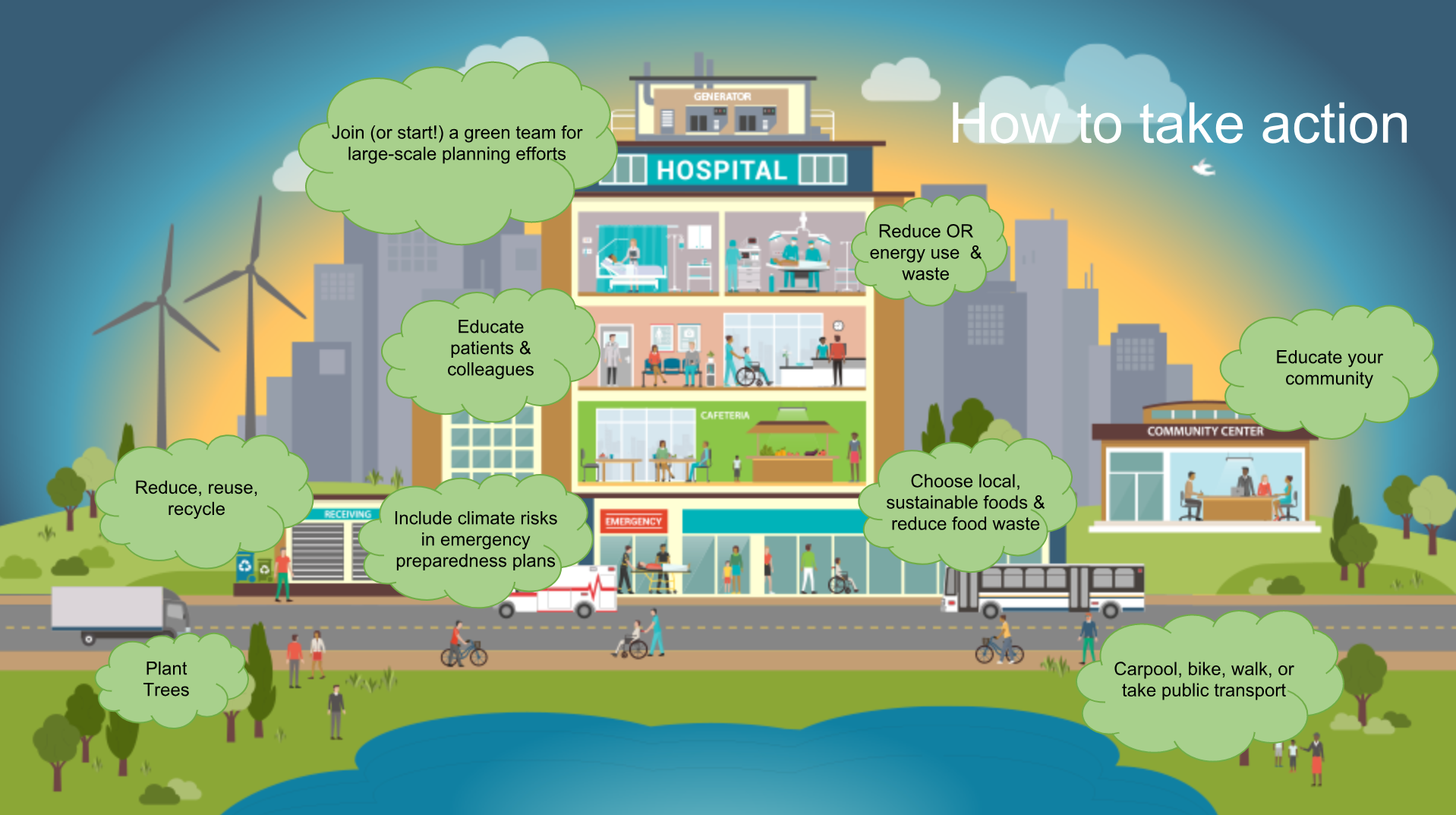Mitigation
 The Climate Action Playbook highlights a wide range of mitigation initiatives implemented
The Climate Action Playbook highlights a wide range of mitigation initiatives implemented
by U.S. Health Care Climate Council members.
The challenge
Scientific reports have emphasized the urgent need for all sectors of society to take swift, meaningful action to reduce greenhouse gas (GHG) emissions and transition to a 100 percent clean energy economy. Without a rapid transformation to a low carbon society, the health threats of a warmer planet will grow increasingly severe and more numerous, especially for the most vulnerable members of our communities. Alternatively, moving away from dirty fossil fuels to renewable energy promotes cleaner air and water, which generate immediate health benefits.
Operating 24/7, hospitals are among the most energy-intensive commercial buildings in the country, using 2.5 times the energy of a typical office building. The footprint of the hospital is vast, ranging from energy consumed, to food procured and served, to waste generated, to how employees commute to work. In order for hospitals to meet their mission of “do no harm,” there must be alignment in every corner of the organization.
Our vision
As the only sector with a healing mission, the health care sector has both a moral responsibility and a historic opportunity to address climate change. Health Care Without Harm envisions a low-carbon, climate-smart health care sector with hospitals and health systems that have set clear, ambitious goals for reducing greenhouse gas emissions, and are meeting those targets by innovating and scaling strategies for low-carbon health care delivery.
In reducing their carbon footprints, hospitals protect patients and communities from the health impacts of climate change, reduce health care costs and improve health equity, and accelerate a societal transition to an equitable low-carbon economy.
Our work
Health Care Without Harm’s Climate and Health program works to support climate-smart health care in hospitals by providing strategies and developing solutions to reduce their carbon footprint in all areas of the hospital: energy and water use, food procurement, supply chain, waste management, transportation, and financial investments.
Health systems can lead the transition to a low-carbon future by setting a net-zero goal for no later than 2050 to limit global warming to 1.5°C and avoid the most catastrophic impacts of climate change. Setting a goal motivates staff and drives strategies for reduction. Once the net-zero goal has been set, develop a plan with interim targets to manage and demonstrate progress towards that goal.
In a video titled “Climate Change - An Urgent Human Health Issue,” Kaiser Permanente CEO Bernard J. Tyson
sums up why they have committed to carbon neutrality by 2020: “It’s about health.”
Once the net-zero goal has been set, develop a plan to meet the reduction goal with interim targets to manage and demonstrate progress towards that goal. There are likely multiple areas across the hospital where reduction work has already started; it just may not yet be identified as emissions reduction.
The Climate Action Playbook highlights a wide range of mitigation initiatives implemented by U.S. Health Care Climate Council members. Climate Council members are innovating inside their facilities and leveraging their purchasing power to drive the transformation to a low-carbon economy. Examples include energy conservation and renewable energy at Gundersen Health, alternative transportation strategies at Seattle Children’s Hospital, and meat reduction efforts at Hackensack Meridian Health.
Reducing GHG emissions not only improves the health of our patients and planet, but also generates substantial cost savings. Practice Greenhealth members report an average of more than $1 million in savings from sustainability-related projects, many of which reduce GHG emissions.
Tools and resources
Working on reducing a hospital or health system’s climate impact doesn’t happen in a silo. This is why our most successful, leading health systems are part of the Practice Greenhealth network, where they learn about and share various strategies for climate mitigation, resilience, and leadership.
The Climate and Health team works with Practice Greenhealth to develop resources on mitigation initiatives. For examples of what is offered in the toolkits, check out the executive summaries below.
- Executive summary: Anesthetic gas toolkit
- Executive summary: Greenhouse gas reduction toolkit
- Executive summary: Transportation toolkit
- Practice Greenhealth: Food waste solutions
- The Path to Carbon Neutral: A Guide to Building a Climate-Smart Health Care System
- Resources on reducing energy and water use, serving less meat and more sustainable foods, and waste management are also available through Practice Greenhealth membership.
Take action
Hospitals and health systems can commit to reducing their climate impact by joining the Health Care Climate Challenge. The Climate Challenge provides participants with a framework to set a goal and benchmark their climate footprint, empowering them to conserve energy and reduce emissions.
Hospitals, health centers, and health systems around the world are increasingly relying on solar, wind, and other sources of clean, renewable electricity to power their facilities. Learn more about why they are making the switch and how your hospital or health system can set a goal for 100% renewable electricity.
Contact
We want to hear from you! For more information, please contact us at climate@hcwh.org.

